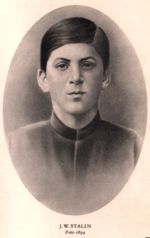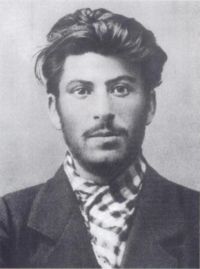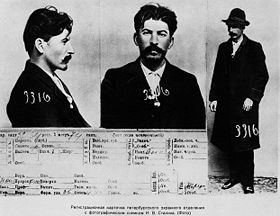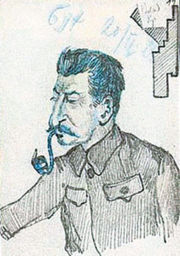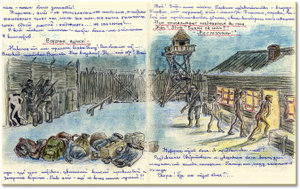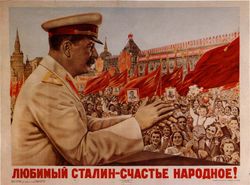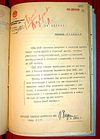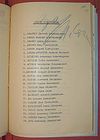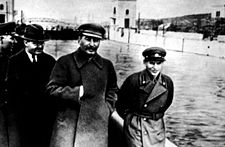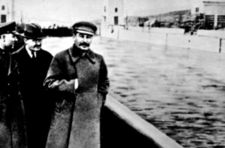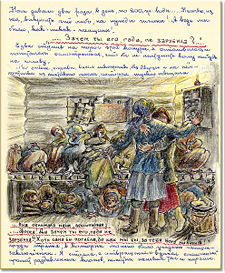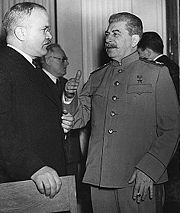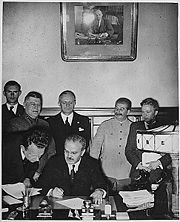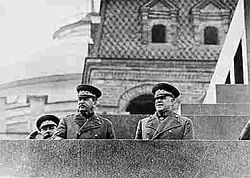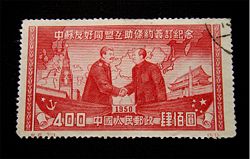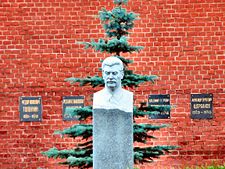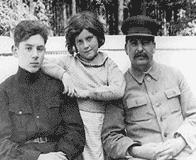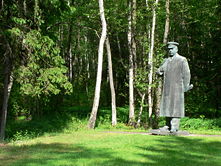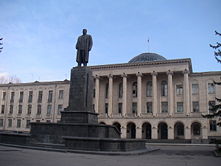Joseph Stalin
2008/9 Schools Wikipedia Selection. Related subjects: Political People
|
Joseph Vissarionovich Stalin
იოსებ ბესრიონის სტალინი Иосиф Виссарионович Сталин |
|
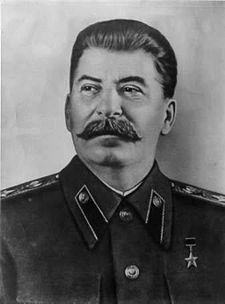 |
|
|
General Secretary of the Communist Party of the Soviet Union
|
|
|---|---|
| In office April 3, 1922 – March 5, 1953 |
|
| Preceded by | None (position created in 1922) |
| Succeeded by | Nikita Khrushchev |
|
Chairman of the Council
of People's Commissars |
|
| In office May 6, 1941 – March 5, 1953 |
|
| Preceded by | Vyacheslav Molotov |
| Succeeded by | Georgy Malenkov |
|
|
|
| Born | December 18, 1878 Gori, Georgia, Russian Empire |
| Died | March 5, 1953 (aged 74) Moscow, Russian SFSR, Soviet Union |
| Nationality | Georgian |
| Political party | Communist Party of the Soviet Union |
| Religion | None (atheist) |
Joseph Stalin (Russian: Иосиф Виссарионович Сталин, Iosif Stalin Georgian: იოსებ სტალინი), born as Iosef Vissarionovich Dzhugashvili December 18 [ O.S. December 6] 1878 – March 5, 1953) was General Secretary of the Communist Party of the Soviet Union's Central Committee from 1922 until his death in 1953. During that time he established the regime now known as Stalinism. He gradually consolidated power and became the de facto party leader and dictator of the Soviet Union.
Following the death of Vladimir Lenin in 1924, Stalin prevailed in a power struggle over Leon Trotsky, who was expelled from the Communist Party and deported from the Soviet Union. Stalin launched a command economy in the Soviet Union replacing the New Economic Policy of the 1920s with Five-Year Plans in 1928 and at roughly the same time, forced rapid industrialization of the largely rural country and collective farming by confiscating the lands of farmers. He derogatorily referred to farmers who refused his reforms as " kulaks", a class of rich peasant which had in actual fact been wiped out by World War One; millions were killed, exiled to Siberia, or died of starvation after their land, homes, meager possessions, and ability to earn an existence from the land were taken to fulfill Stalin's vision of massive "factory farms". While the Soviet Union transformed from an agrarian economy to a major industrial powerhouse in a short span of time, millions of people died from hardships and famine that occurred as a result of the severe economic upheaval and party policies.
At the end of 1930s, Stalin launched the Great Purge, a major campaign of political repression. During his continued repressions, millions of people who were a threat to the Soviet politics or suspected of being such a threat were executed or exiled to Gulag labor camps in remote areas of Siberia or Central Asia, where many more died of disease, malnutrition and exposure. A number of ethnic groups in Russia were forcibly resettled for political reasons. Stalin's rule, reinforced by a cult of personality, fought real and alleged opponents mainly through the security apparatus, such as the NKVD. In the 1950s Nikita Khrushchev, Stalin's eventual successor, denounced Stalin's rule and the cult of personality, thus initiating the process of " de-Stalinization".
Bearing the brunt of the Nazis' attacks, the Soviet Union under Stalin made the largest and most decisive contribution to the defeat of Nazi Germany during World War II (1939–1945). Some historians believe Stalin contributed to starting World War II because of his secret agreement with Nazi Germany to carve up the nation of Poland, as part of the Molotov-Ribbentrop Pact of 1939. This led to the Soviet Union's invasion of Poland from the east later that same year, following Nazi Germany's invasion of western Poland. Under Stalin's leadership after the war, the Soviet Union went on to achieve recognition as one of just two superpowers in the world. That status lasted for nearly four decades after his death until the dissolution of the Soviet Union. Stalin's rule had long-lasting effects on the features that characterized the Soviet state from the era of his rule to its collapse in 1991.
Childhood and education, 1878–1899
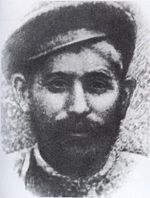 |
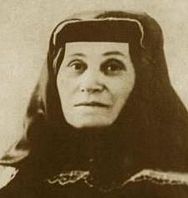 |
| Official portrait of Stalin's father, Besarion | Stalin's mother, Ketevan |

Joseph Stalin was born Ioseb Besarionis Dzhugashvili in Gori, Georgia to Besarion Dzhugashvili and Ketevan Geladze. Stalin's mother was born a serf. His father was a cobbler and owned his own workshop. He was their third child; their two previous sons died in infancy. The second and third toes of his left foot were webbed.
Initially, the Dzhugashvilis' lives were prosperous and happy, but Stalin's father became an alcoholic, which gradually led to his business failing and becoming violently abusive to his wife and child. As their financial situation grew worse, Stalin's family moved homes frequently; at least nine times in Stalin's first ten years of life.
The town where Stalin grew up was a violent and lawless place. It had only a small police force and a culture of violence that included gang-warfare, organized street brawls and wrestling tournaments - some of which were traditions inherited from Georgia's war-torn past. Stalin took part in streetfighting as a child; he was not afraid to challenge opponents who were much stronger than he, and he was severely beaten on numerous occasions.
At the age of 7, Stalin fell ill with smallpox and his face was badly scarred by the disease. He later had photographs retouched to make his pockmarks less apparent. Stalin's native tongue was Georgian. He started learning Russian only when he was eight or nine years old, and he never lost his strong Georgian accent.
At the age of 10, Stalin began his education at the Gori Church School. His peers were mostly the sons of affluent priests, officials, and merchants. He and most of his classmates at Gori were Georgians and spoke mostly Georgian. However, at school they were forced to speak Russian, which was the policy of Tsar Alexander III. Their Russian teachers mocked the accents of their Georgian students, and regarded their language and culture as inferior. Nevertheless, Stalin earned the respect and admiration of his teachers by being the best student in the class, earning top marks across the board. He developed a passion for learning that stayed with him for the rest of his life. He became a very good choir singer and was often hired to sing at weddings. He also began to write poetry, something he would develop in later years.
Stalin's father, who had always wanted his son to be trained as a cobbler rather than be educated, was infuriated when the boy was accepted into the school. In his anger he smashed the windows of the local tavern, and later attacked the town police chief. Out of compassion for Stalin's mother, the police chief did not arrest Besarion, but ordered him to leave town. He moved to Tiflis where he found work in a shoe factory and left his family behind in Gori.
About the time Stalin began school, he was struck by a horse-drawn carriage. The accident permanently damaged his left arm; this injury would later exempt him from military service in World War I. At the age of 12, Stalin was struck again by a horse-drawn carriage and injured badly. He was taken to hospital in Tiflis where he spent months in care. After he recovered, his father seized the opportunity to kidnap the boy and enroll him as an apprentice cobbler at the shoe factory where he worked. When his mother, through the aid of contacts in the clergy and school staff, recovered the boy, his father cut off all financial support to his wife and son, leaving them to fend for themselves. Stalin returned to his school in Gori where he continued to excel.
He graduated first in his class and in 1894, at the age of 16, he enrolled at the Georgian Orthodox Seminary of Tiflis, to which he had been awarded a scholarship. The teachers at Tiflis Seminary were also determined to impose Russian language and culture on the Georgian students. Like many of his comrades, young Stalin reacted by being drawn to Georgian patriotism. During this time he gained fame as a poet; his poems were published in several local newspapers. However, his interest for poetry began to fade as he was drawn to rebellion and revolution.
During his time at the seminary, Stalin and numerous other students read forbidden literature that included Victor Hugo novels and revolutionary, including Marxist, material. He was caught and punished numerous times for this. One teacher in particular - Father Abashidze, whom Stalin nicknamed "the Black Spot" - harassed the rebel students through student informers, nightly patrols and surprise dormitory raids. This personal experience of "surveillance, spying, invasion of inner life, violation of feelings", in Stalin's own words, influenced the design of his future terror state. He became an atheist in his first year. He insisted his peers call him "Koba", after the Robin Hood-like protagonist of the novel The Patricide by Alexander Kazbegi; he would continue to use this pseudonym as a revolutionary. In August 1898, he joined the Russian Social-Democratic Labour Party, an organisation from which the Bolsheviks would later form.
Shortly before the final exams, the Seminary abruptly raised school fees. Unable to pay, Stalin quit the seminary in 1899 and missed his exams, for which he was officially expelled. Twenty of his fellow-classmates were expelled for revolutionary activities in 1899, and forty more were expelled in 1901. Shortly after leaving school, Stalin discovered the writings of Vladimir Lenin and decided to become a revolutionary.
Early years as a Marxist revolutionary, 1899–1917
After abandoning his priestly education, Stalin took a job as a weatherman at the Tiflis Meteorological Observatory. Although the pay was relatively low (20 roubles a month), his workload was light, giving him plenty of time for revolutionary activities. He would organise strikes, lead demonstrations and give speeches. He soon caught the attention of the Tsar's secret police, the Okhrana. During this time he met and charmed Simon Ter-Petrossian, a violent psychopath who became his long-time henchman and enforcer.
On the night of April 3 1901 the Okhrana arrested a number of SD Party leaders in Tiflis, but Stalin spotted their agents waiting in ambush at the Observatory and avoided capture. He went underground, becoming a full-time revolutionary, living off donations from friends, sympathizers and his Party. He began writing revolutionary articles for the Baku-based radical newspaper Brdzola ("Struggle").
In October, Stalin fled to Batumi and got work at an oil refinery owned by the Rothschild family. Organizing the workers there, Stalin was almost certainly involved in a 1902 fire at the refinery designed to trick the management into giving the workers a bonus for putting out the fire. However, the manager suspected arson and refused to pay. This led to a series of strikes, all organized by Stalin, which in turn led to arrests and clashes with the Cossacks in the streets. In one attempt to break their comrades out of prison, thirteen strikers were killed when Cossacks intervened. Stalin distributed incendiary pamphlets portraying the dead as martyrs. On April 18 1902, the authorities finally arrested Stalin at one of his secret meetings. At his trial, Stalin was acquitted of leading the riots due to lack of evidence, but was kept in custody whilst the authorities investigated his activities in Tiflis. In 1903, the authorities decided to exile Stalin to Siberia for three years.
Stalin ended up in the Siberian town of Novaya Uda on December 9 1903. During this time, he heard that two rival factions within the Social-Democrats had formed: the Bolsheviks under Lenin and the Mensheviks under Julius Martov. Stalin, already an admirer, decided to become a Leninist. Stalin managed to obtain false papers and, on January 17 1904, escaped Siberia by train, arriving back in Tiflis ten days later.
With no income, Stalin lived off his circle of friends. One of them introduced him to Lev Kamenev (then known as Lev Rosenfeld), his future co-ruler of the USSR after Lenin's death. At this time, Stalin favored a Georgian Social-Democratic party, which caused a rift with the majority who favored international Marxism. Threatened with expulsion, he was forced to write Credo, a paper renouncing his views (because this paper distanced himself from Lenin, when Stalin became ruler of the USSR, he tried to destroy all copies of this Credo, and many of those who had read it were shot).
In February 1904, the Russo-Japanese War broke out between Japan and Russia. The war, which would eventually end in Russia's defeat, severely strained the Russian economy and caused a great deal of restlessness in Georgia. Stalin travelled across Georgia conducting political activity for his party. He also worked to undermine the Mensheviks through a campaign of slander and intrigue; his efforts brought him to Lenin's attention for the first time.
On January 22 1905, Stalin was in Baku when Cossacks attacked a mass demonstration of workers, killing two hundred. This sparked off the Russian Revolution of 1905. Riots, peasant uprisings and ethnic massacres swept the Russian Empire. In February, ethnic Azeris and Armenians were slaughtering each other in the streets of Baku. Commanding a squad of armed Bolsheviks, Stalin ran protection rackets to raise Party funds and stole printing equipment. Afterwards, he headed west, where continued to campaign against the Mensheviks, who enjoyed overwhelming support in Georgia. In the mining town of Chiatura, both Stalin and the Mensheviks competed for the support of the miners; they chose Stalin, being more swayed by his plain and concise manner of speaking than the flamboyant oratory of the Menshevik speaker. From Chiatura, Stalin organized and armed Bolshevik militias across Georgia. With them, he ran protection rackets among the wealthy and waged guerilla warfare on Cossacks, policemen and the Okhrana. Later that year in Tiflis, he met Ekaterina Svanidze, who would become his first wife.
In December 1905, Stalin and two other were elected to represent the Caucusus at the next Bolshevik conference, which took place in Tammerfors, Finland. There, on January 7 1906, Stalin met Lenin in person for the first time. Although Stalin was impressed by Lenin's personality and intellect, he was not afraid to contradict him. He objected to Lenin's proposal that they take part in elections to the recently-formed Duma; Lenin conceded to Stalin. At the conference he also met Emelian Yaroslavsky, his future propaganda chief, and Solomon Lozovsky, his future Deputy Foreign Commissar.
After the conference, Stalin returned to Georgia, where Cossack armies were brutally working to reconquer the rebellious region for the Tsar. In Tiflis, Stalin and the Mensheviks plotted the assassination of General Fyodo Griiazanov, which was carried out on March 1 1906. Stalin continued to raise money for the Bolsheviks through extortion, bank robberies and hold-ups.
In April 1906, Stalin attended the Fourth Congress of the Russian Social Democratic Labour Party. At the conference, he met Klimenti Voroshilov, his future Defence Commissar and First Marshal; Felix Dzerzhinsky, future founder of the Cheka; and Grigory Zinoviev, with whom he would share power after Lenin's death. The Congress - in which the Bolsheviks were outnumbered - voted to ban bank robberies. This upset Lenin, who needed the bank robberies to raise money.
Stalin married Ekaterina Svanidze on the night of July 28 1906. On March 31 1907, she gave birth to Stalin's first child, Yakov.
Stalin and Lenin both attended the Fifth Congress of the Russian Social Democratic Labour Party in London in 1907. This Congress consolidated the supremacy of Lenin's Bolshevik faction and debated strategy for communist revolution in Russia. Here, Stalin first met Leon Trotsky in person; Stalin immediately came to hate him, calling him "pretty but useless". After the conference, Stalin began switching his focus away from Georgia, which was rife with feuding and dominated by the Mensheviks, to Russia; he began writing in Russian.
Upon his return to Tiflis, Stalin readied himself for a major bank robbery. Through contacts in the banking business, he had learned a major shipment of money was due to be delivered in June to the Imperial Bank at the centre of town. Because his party banned bank robberies, Stalin temporarily resigned. On June 26 1907, Stalin's gang ambushed the armed convoy when it entered Yerevan Square with gunfire and homemade bombs. Around forty people were killed, but all of Stalin's gang managed to escape alive with 250,000 roubles (around US$3.4 million in today's terms). Stalin and his family left Tiflis two days later. His henchman Kamo delivered the money to Lenin in Finland, who then fled with it to Geneva. The Mensheviks, who had banned bank robberies (and didn't get to share in the loot), were outraged and investigated the suspects. Stalin escaped expulsion, though the affair would cause him trouble for years to come.
Stalin's family moved to Baku. Whilst Stalin continued his revolutionary activities, his wife fell ill from Baku's pollution, heat, stress and malnourishment. She eventually contracted typhus (though many historians believe it to have been tuberculosis) and died on December 5 1907. Stalin was overcome with grief and retreated into mourning for several months. The loss also hardened him; he told a friend: "with her died my last warm feelings for humanity". He abandoned his son, Yakov, who was raised by his deceased wife's family.
When Stalin resumed his activities, he organized more strikes and agitation, this time focusing on the Muslim Azeri and Persian workers in Baku. He helped found a Muslim Bolshevik group called Himmat, and also supported Persian Constitutional Revolution with manpower and weapons, and even visited Persia to organize partisans. Stalin ordered the murders of many Black Hundreds (right-wing supporters of the Tsar), and conducted protection rackets and ransom kidnappings against the oil tycoons of Baku . He also operated counterfeiting operations, robberies and protection rackets. He befriend the criminal gangs, and used them to obstruct Mensheviks. Stalin's gangsterism upset the Bolshevik intelligentsia, but he was too influential and indispensable to oppose.
The Okhrana tracked down and arrested Stalin on April 7 1908. After seven months in prison, he was sentenced to two years exile in Siberia. He arrived in the village of Solvychegodsk in early March 1909. After seven months in exile, he disguised himself as a woman and escaped on a train to St Petersburg. He returned to Baku in late July.
The Bolsheviks were on the verge of collapse due to Okhrana oppression within the Empire and infighting among the intelligentsia abroad. In desperation, he advocated a reconciliation with the Mensheviks (which Lenin opposed). He demanded the creation of a Russian Bureau to run the Social-Democratic Party from within the Empire, to which he was appointed.
Stalin soon realised the Bolsheviks had been heavily infiltrated by Tsarist spies. He initiated a witch-hunt for traitors, however, he failed to root out any real traitors - as revealed by Okhrana records - and his efforts caused much disarray in the Party.
On April 5 1910 Stalin was yet again arrested by the Okhrana. He was banned from the Caucasus for five years and sentenced to complete his previous exile in Solvychegodsk. He was deported back there in September. He briefly escaped in early 1911, but another exile who was supposed to pass much-needed money to him instead ran off with it (Stalin would have him shot for this in 1937), and he was forced to return to Solvychegodsk. During his exile, he had an affair with his landlady, Maria Kuzakova, with whom he fathered a son, Constantine. Stalin was released on July 9 1911, while Maria was still pregnant. Stalin moved to Vologda in late July, where he had been ordered to reside for two months.
In January 1912, at the Prague Party Conference, Lenin led his Bolshevik faction out of the Russian Social Democratic Labor Party, founding the separate Bolshevik Party. A Central Committee was elected, but when some of its members returned to Russia, they were arrested by the Okhrana, having been secretly betrayed by fellow CC member Roman Malinovsky, an Okhrana spy. To fill the void, Lenin and Grigory Zinoviev coopted Stalin as a member of the Central Committee. When Stalin was informed of this, he left Vologda in late February.
Stalin moved to Saint Petersburg in April 1912, where he took control of the Bolshevik weekly newspaper Zvezda. Stalin had been assigned to convert Zvezda into a daily and rename it Pravda. The first issue was published on May 5.
Shortly afterwards, the Okhrana caught up with him again, and in July 1912 he was exiled again to Siberia for three years, this time in the small village of Narym. He escaped just thirty-eight days after arriving; this was his shortest exile. He returned to Saint Petersburg in September.
Stalin made efforts to reconcile the Bolsheviks with the Mensheviks in hopes of salvaging the struggling Marxist movement. He published editorials in Pravda advocating reconciliation, and secretly met with Menshevik leaders on several occasions. This angered Lenin, who twice summoned Stalin to Kraków to argue policy. On the second visit at the end of 1912, Stalin was removed from his post as editor of Pravda, but was made a leader of the Russian Bureau of the Bolshevik Party. Lenin also asked Stalin to write an essay laying out the Bolshevik position on national minorities.
After Kraków, Stalin spent several weeks in Vienna with the Troyanovskys, a wealthy Bolshevik couple he met with Lenin in Kraków. Whilst there he met for the first time Nikolai Bukharin, who would become a leading politician in the future Soviet government. They continued to discuss the issue of nationalities. Stalin completed his essay on the topic, entitled "Marxism and the National Question", which was published in March 1913 under the pseudonym "K. Stalin" (this was the first time he used the name "Stalin" in a publishing; he began using this alias in 1912).
Stalin returned to Saint Petersburg in February 1913. During this time, many Bolsheviks, including almost the entire Central Committee, had been arrested by the Okhrana, having been betrayed by Roman Malinovsky, a high-ranking Bolshevik who for years had been an Okhrana spy and agent provocateur. That month, an article had been published that outed Malinovsky as a spy, but the Bolsheviks dismissed it as Menshevik libel (ironically, Lenin and Stalin were his strongest defenders). On March 8 Malinovsky persuaded Stalin to attend a Bolshevik fundraising ball, which was raided by the Okhrana.
Stalin was condemned to four years in the remote Siberian province of Turukhansk. He was eventually joined by Kamenev and several other Bolshevik exiles. He spent six months in the small hamlet of Kostino on the Yenisei River. After learning that Stalin was planning an escape (he had received money and supplies from his comrades), the authorities moved him north to Kureika, a hamlet on the edge of the Arctic Circle. There, he lived the life of a hunter-gatherer, having learned fishing and hunting from the local Siberian tribesmen. While there he began a 2-year affair with Lidia Pereprygina, then aged 13, with whom he fathered two children. The first died in infancy; the second, named Alexander, was born in April 1917.
In late 1916, Stalin was conscripted into the army. He was taken Krasnoyarsk in February 1917, but the medical examiner there found him unfit for service due to his damaged left arm (a childhood injury). He spent his last four months of exile in the village of Achinsk.
Russian Revolution of 1917
In the wake of the February Revolution of 1917 (the first phase of the Russian Revolution of 1917), Stalin was released from exile. On March 25 he returned to Petrograd (Saint Petersburg) and, together with Lev Kamenev and Matvei Muranov, ousted Vyacheslav Molotov and Alexander Shlyapnikov as editors of Pravda, the official Bolshevik newspaper, while Lenin and much of the Bolshevik leadership were still in exile. Stalin and the new editorial board took a position in favour of supporting Alexander Kerensky's provisional government (Molotov and Shlyapnikov had wanted to overthrow it) and went to the extent of declining to publish Lenin's articles arguing for the provisional government to be overthrown. However, after Lenin prevailed at the April Party conference, Stalin and the rest of the Pravda staff came on board with Lenin's view and called for overthrowing the provisional government. At this April 1917 Party conference, Stalin was elected to the Bolshevik Central Committee with the third highest total votes in the party.
In mid-July, armed mobs led by Bolshevik militants took to the streets of Petrograd, killing army officers and bourgeois civilians. They demanded the overthrow of the government, but neither the Bolshevik leadership nor the Petrograd Soviet were willing to take power, having been totally surprised by this unplanned revolt. After the disappointed mobs dispersed, Kerensky's government struck back at the Bolsheviks. Loyalist troops raided Pravda and surrounded the Bolshevik headquarters. Stalin helped Lenin evade capture and, to avoid a bloodbath, ordered the besieged Bolsheviks to surrender.
Convinced Lenin would be killed if caught, Stalin smuggled him to Finland. In Lenin's absence, Stalin assumed leadership of the Bolsheviks. At the Sixth Congress of the Bolshevik party, held secretly in Petrograd, Stalin was chosen to be the chief editor of the Party press and a member of the Constituent Assembly, and was re-elected to the Central Committee.
In September 1917, Kerensky suspected his newly-appointed Commander-in-Chief, General Lavr Kornilov, of planning a coup and dismissed him. Believing Kerensky was being controlled by the Bolsheviks, Kornilov decided to march his army on Petrograd. In desperation, Kerensky turned to the Petrograd Soviet for help and released the Bolsheviks, who together raised a small army to defend the capital. In the end, Kerensky convinced Kornilov's army to stand down and disband without violence. However, the Bolsheviks were now free, rearmed and swelling with new recruits and under Stalin's firm control, whilst Kerensky had few troops loyal to him in the capital. Lenin decided the time for a coup had arrived. Kamenev and Zinoviev proposed a coalition with the Mensheviks, but Stalin and Trotsky backed Lenin's wish for an exclusively Bolshevik government. Lenin returned to Petrograd in October. On October 29, the Central Committee voted 10-2 in favour of an insurrection; Kamenev and Zinoviev voted in opposition.
On the morning of November 6, Kerensky's troops raided Stalin's press headquarters and smashed his printing presses. Whilst he worked to restore his presses, he missed a Central Committee meeting where assignments for the coup were being issued. Stalin instead spent the afternoon briefing Bolshevik delegates and passing communications to and from Lenin, who was in hiding.
Early the next day, Stalin went to the Smolny Institute from where he, Lenin and the rest of the Central Committee coordinated the coup. Kerensky left the capital to rally the Imperial troops at the German front. By November 8, the Winter Palace had been stormed and Kerensky's Cabinet had been arrested.
Rise to power, 1917–1927
| Communist Party of the Soviet Union |
|
Party History |
|
Party Organization |
|
Leaders |
|
Pravda |
| Communism Portal |
Upon seizing Petrograd, the Bolsheviks formed the new revolutionary authority, the Council of People's Commissars. Stalin was appointed People's Commissar for Nationalities' Affairs; his job was to establish an institution to win over non-Russian citizens of the former Russian Empire. He was relieved of his post as editor of Pravda so that he could devote himself fully to his new role.
In March 1918, the Menshevik leader Julius Martov published an article exposing Bolshevik crimes committed before the revolution. It stated that Stalin had organised bank robberies and had been expelled from his own party for doing so (the latter part is untrue). Stalin sued Martov for libel and won.
After seizing Petrograd, civil war broke out in Russia, pitting Lenin's Red Army against the White Army, a loose alliance of anti-Bolshevik forces. Lenin formed a five-member Politburo which included Stalin and Trotsky. During this time, only Stalin and Trotsky were allowed to see Lenin without an appointment.
In April 1918, Lenin dispatched Stalin to the city of Tsaritsyn. Situated on the Lower Volga, it was a key supply route to the oil and grain of the North Caucasus, and it was in danger of falling to the White Army. Stalin ordered the executions of any suspected counter-revolutionaries. Here, he first met and befriended Kliment Voroshilov and Semyon Budyonny, both of whom would become two of Stalin's key supporters in the military. As the military situation grew worse, Stalin effectively took control of the Red Army. When Trotsky had formed the Red Army, he recruited many former Tsarist officers for their expertise, but Stalin distrusted them and had many of them killed, much to Trotsky's anger.
On his return to Moscow in 1919, Stalin married Nadezhda Alliluyeva, his second wife.
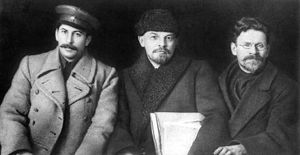
During the Russian Civil War and Polish-Soviet War Stalin was a political commissar in the Red Army at various fronts. Stalin's first government position was as People's Commissar of Nationalities Affairs (1917–1923). In that position he traveled to Finland in late 1917, and promised the socialists there that the RSFSR would aid their revolution. However, this aid was never given and the revolution in Finland was defeated.
He was also People's Commissar of the Workers and Peasants Inspection (1919–1922), a member of the Revolutionary Military Council of the republic (1920–1923) and a member of the Central Executive Committee of the Congress of Soviets (from 1917).
Stalin played a decisive role in engineering the 1921 Red Army invasion of Georgia following which he adopted particularly hardline, centralist policies towards Soviet Georgia, which included severe repression of all opposition within the local Communist party (e.g., the Georgian Affair of 1922), not to mention any manifestations of anti-Sovietism (the August Uprising of 1924). It was in the Georgian affairs that Stalin first began to play his own hand.
On April 3, 1922, with the aid of Lenin and Kamenev, Stalin was appointed General Secretary of the Central Committee of the Communist Party. This position was seen to be a minor one (Stalin was sometimes referred to as "Comrade Card-Index" by fellow party members). Combined with the leadership over the Orgburo, however, this position had a potential power base as it allowed him to appoint his supporters to key positions within the government and party.
Later, in 1924, Stalin himself created a myth around a so-called "Party Centre" which "directed" all practical work pertaining to the uprising, consisting of himself, Sverdlov, Dzerzhinsky, Uritsky, and Bubnov. No evidence was ever shown for the activity of this "centre", which would, in any case, have been subordinate to the Military Revolutionary Council, headed by Trotsky.
Campaign against the left and right opposition
After Lenin's death in January 1924, Stalin, Kamenev, and Zinoviev together governed the party, placing themselves ideologically between Trotsky (on the left wing of the party) and Bukharin (on the right). During this period, Stalin abandoned the traditional Bolshevik emphasis on international revolution in favour of a policy of building " Socialism in One Country", in contrast to Trotsky's theory of Permanent Revolution.
In the struggle for leadership after Lenin's death one thing was evident; whoever ended up ruling the party had to demonstrate fealty to the memory of Lenin. Stalin did so by organizing the late leader's funeral, after which he made a speech professing an undying loyalty to Lenin that was almost religious in nature.
Stalin's actual relationship with Lenin, which was far more complex than Stalin's speeches alluded, has been illuminated by a number of sources that were made available after the fall of the Soviet Union, including some from Lenin's sister.
Stalin first worked to undermine Trotsky, who was sick at the time, possibly by misleading him about the date of the funeral. Consequently, Trotsky, who was Lenin’s associate throughout the early days of the Soviet regime, lost considerable political support. Stalin made great deal of the fact that Trotsky had joined the Bolsheviks just before the revolution, and publicized Trotsky's pre-revolutionary disagreements with Lenin. Another event that helped Stalin's rise was the fact that Trotsky came out against publication of Lenin's Testament in which he pointed out the strengths and weaknesses of Stalin and Trotsky and the other main players, and suggested that he be succeeded by a small group of people.
An important feature of Stalin’s rise to power is the way that he manipulated his opponents and played them off against each other. Stalin formed a " troika" of himself, Zinoviev, and Kamenev against Trotsky. When Trotsky had been eliminated, Stalin then joined Bukharin and Rykov against Zinoviev and Kamenev, emphasising their vote against the insurrection in 1917. Zinoviev and Kamenev then turned to Lenin's widow, Krupskaya; they formed the " United Opposition" in July 1926.
In 1927 during the 15th Party Congress Trotsky and Zinoviev were expelled from the party and Kamenev lost his seat on the Central Committee. Stalin soon turned against the " Right Opposition", represented by his erstwhile allies, Bukharin and Rykov.
Stalin gained popular appeal from his presentation as a 'man of the people' from the poorer classes. The Russian people were tired from the world war and the civil war, and Stalin's policy of concentrating in building "Socialism in One Country" was seen as an optimistic antidote to war.
Stalin took great advantage of the ban on factionalism which meant that no group could openly go against the policies of the leader of the party because that meant creation of an opposition. By 1928 (the first year of the Five-Year Plans) Stalin was supreme among the leadership, and the following year Trotsky was exiled because of his opposition. Having also outmaneuvered Bukharin's Right Opposition and now advocating collectivization and industrialization, Stalin can be said to have exercised control over the party and the country.
However, as the popularity of other leaders such as Sergei Kirov and the so-called Ryutin Affair were to demonstrate, Stalin did not achieve absolute power until the Great Purge of 1936–1938.
Soviet secret service and intelligence
Stalin vastly increased the scope and power of the state's secret police and intelligence agencies. Under his guiding hand, Soviet intelligence forces began to set up intelligence networks in most of the major nations of the world, including Germany (the famous Rote Kappelle spy ring), Great Britain, France, Japan, and the United States. Stalin saw no difference between espionage, communist political propaganda actions, and state-sanctioned violence, and he began to integrate all of these activities within the NKVD. Stalin made considerable use of the Communist International movement in order to infiltrate agents and to ensure that foreign Communist parties remained pro-Soviet and pro-Stalin.
One of the best examples of Stalin's ability to integrate secret police and foreign espionage came in 1940, when he gave approval to the secret police to have Leon Trotsky assassinated in Mexico.
Changes to Soviet society, 1927–1939
Industrialization
The Russian Civil War and wartime communism had a devastating effect on the country's economy. Industrial output in 1922 was 13% of that in 1914. A recovery followed under the New Economic Policy, which allowed a degree of market flexibility within the context of socialism.
Under Stalin's direction, this was replaced by a system of centrally ordained "Five-Year Plans" in the late 1920s. These called for a highly ambitious program of state-guided crash industrialization and the collectivization of agriculture.
With seed capital unavailable because of international reaction to Communist policies, little international trade, and virtually no modern infrastructure, Stalin's government financed industrialization both by restraining consumption on the part of ordinary Soviet citizens to ensure that capital went for re-investment into industry, and by ruthless extraction of wealth from the kulaks.
In 1933 workers' real earnings sank to about one-tenth of the 1926 level. Common and political prisoners in labor camps were forced to do unpaid labor, and communists and Komsomol members were frequently "mobilized" for various construction projects. The Soviet Union used foreign experts, e.g. British engineer Stephen Adams, to instruct their workers and improve their manufacturing processes.
In spite of early breakdowns and failures, the first two Five-Year Plans achieved rapid industrialization from a very low economic base. While it is generally agreed that the Soviet Union achieved significant levels of economic growth under Stalin, the precise rate of growth is disputed. It is not disputed, however, that these gains were accomplished at the cost of millions of lives.
Official Soviet estimates stated the annual rate of growth at 13.9%; Russian and Western estimates gave lower figures of 5.8% and even 2.9%. Indeed, one estimate is that Soviet growth became temporarily much higher after Stalin's death.
According to Robert Lewis the Five-Year Plan substantially helped to modernize the previously backward Soviet economy. New products were developed, and the scale and efficiency of existing production greatly increased. Some innovations were based on indigenous technical developments, others on imported foreign technology.
Collectivization
Stalin's regime moved to force collectivization of agriculture. This was intended to increase agricultural output from large-scale mechanized farms, to bring the peasantry under more direct political control, and to make tax collection more efficient. Collectivization meant drastic social changes, on a scale not seen since the abolition of serfdom in 1861, and alienation from control of the land and its produce. Collectivization also meant a drastic drop in living standards for many peasants, and it faced violent reaction among the peasantry.
In the first years of collectivization it was estimated that industrial production would rise by 200% and agricultural production by 50%, but these estimates were not met. Stalin blamed this unanticipated failure on kulaks (rich peasants), who resisted collectivization. (However, kulaks proper made up only 4% of the peasant population; the "kulaks" that Stalin targeted included the slightly better-off peasants who took the brunt of violence from the OGPU and the Komsomol. These peasants were about 60% of the population). Those officially defined as "kulaks," "kulak helpers," and later "ex-kulaks" were to be shot, placed into Gulag labor camps, or deported to remote areas of the country, depending on the charge.
The two-stage progress of collectivization—interrupted for a year by Stalin's famous editorial, " Dizzy with success" ( Pravda, March 2, 1930), and " Reply to Collective Farm Comrades" (Pravda, April 3, 1930)—is a prime example of his capacity for tactical political withdrawal followed by intensification of initial strategies.
Many historians assert the disruption caused by collectivization was largely responsible for major famines.
The 1932–1933 famine in Ukraine and the Kuban regions has been termed the Holodomor (Ukrainian: Голодомор).
According to Alan Bullock, "the total Soviet grain crop was no worse than that of 1931 … it was not a crop failure but the excessive demands of the state, ruthlessly enforced, that cost the lives of as many as five million Ukrainian peasants." Stalin refused to release large grain reserves that could have alleviated the famine, while continuing to export grain; he was convinced that the Ukrainian peasants had hidden grain away, and strictly enforced draconian new collective-farm theft laws in response.
Other historians hold it was largely the insufficient harvests of 1931 and 1932 caused by a variety of natural disasters that resulted in famine, with the successful harvest of 1933 ending the famine.
Famine affected other parts of the USSR. The death toll from famine in the Soviet Union at this time is estimated at between five and ten million people. The worst crop failure of late tsarist Russia, in 1892, had caused 375,000 to 400,000 deaths.
Soviet and other historians have argued that the rapid collectivization of agriculture was necessary in order to achieve an equally rapid industrialization of the Soviet Union and ultimately win World War II. This is disputed by other historians; Alec Nove claims that the Soviet Union industrialized in spite of, rather than because of, its collectivized agriculture.
Science
Science in the Soviet Union was under strict ideological control by Stalin and his government, along with art and literature. There was significant progress in "ideologically safe" domains, owing to the free Soviet education system and state-financed research. However, in several cases the consequences of ideological pressure were dramatic—the most notable examples being the " bourgeois pseudosciences" genetics and cybernetics.
In the late 40's, some areas of physics, especially quantum mechanics but also special and general relativity, were also criticized on grounds of " idealism". Soviet physicists, such as K. V. Nikolskij and D. Blokhintzev, developed a version of the statistical interpretation of quantum mechanics, which was seen as more adhering to the principles of dialectical materialism. However, although initially planned, this process did not go as far as defining an "ideologically correct" version of physics and purging those scientists who refused to conform to it, because this was recognized as potentially too harmful to the Soviet nuclear program.
Linguistics was the only area of Soviet academic thought to which Stalin personally and directly contributed. At the beginning of Stalin's rule, the dominant figure in Soviet linguistics was Nikolai Yakovlevich Marr, who argued that language is a class construction and that language structure is determined by the economic structure of society. Stalin, who had previously written about language policy as People's Commissar for Nationalities, read a letter by Arnold Chikobava criticizing the theory. He "summoned Chikobava to a dinner that lasted from 9 p.m. to 7 a.m. taking notes diligently." In this way he grasped enough of the underlying issues to coherently oppose this simplistic Marxist formalism, ending Marr's ideological dominance over Soviet linguistics. Stalin's principal work discussing linguistics is a small essay, "Marxism and Linguistic Questions."
Although no great theoretical contributions or insights came from it, neither were there any apparent errors in Stalin's understanding of linguistics; his influence arguably relieved Soviet linguistics from the sort of ideologically driven theory that dominated genetics.
Scientific research was hindered by the fact that many scientists were sent to labor camps (including Lev Landau, later a Nobel Prize winner, who spent a year in prison in 1938–1939) or executed (e.g. Lev Shubnikov, shot in 1937). They were persecuted for their dissident views, not for their research. Nevertheless, much progress was made under Stalin in some areas of science and technology. It laid the ground for the famous achievements of Soviet science in the 1950s, such as the development of the BESM-1 computer in 1953 and the launching of Sputnik in 1957.
Indeed, many politicians in the United States expressed a fear, after the " Sputnik crisis," that their country had been eclipsed by the Soviet Union in science and in public education.
Social services
Under the Soviet government people benefited from some social liberalization. Girls were given an adequate, equal education and women had equal rights in employment, improving lives for women and families. Stalinist development also contributed to advances in health care, which significantly increased the lifespan and quality of life of the typical Soviet citizen. Stalin's policies granted the Soviet people universal access to healthcare and education, effectively creating the first generation free from the fear of typhus, cholera, and malaria. The occurrences of these diseases dropped to record low numbers, increasing life spans by decades.
Soviet women under Stalin were the first generation of women able to give birth in the safety of a hospital, with access to prenatal care. Education was also an example of an increase in standard of living after economic development. The generation born during Stalin's rule was the first near-universally literate generation. Millions benefitted from mass literacy campaigns in the 1930s, and from workers training schemes. Engineers were sent abroad to learn industrial technology, and hundreds of foreign engineers were brought to Russia on contract. Transport links were improved and many new railways built. Workers who exceeded their quotas, Stakhanovites, received many incentives for their work; they could afford to buy the goods that were mass-produced by the rapidly expanding Soviet economy.
The increase in demand due to industrialization and the decrease in the workforce due to World War II and repressions generated a major expansion in job opportunities for the survivors, especially for women.
Culture
Although born in Georgia, Stalin became a Russian nationalist and significantly promoted Russian history, language, and Russian national heroes, particularly during the 1930s and 1940s. He held the Russians up as the elder brothers of the non-Russian minorities.
During Stalin's reign the official and long-lived style of Socialist Realism was established for painting, sculpture, music, drama and literature. Previously fashionable "revolutionary" expressionism, abstract art, and avant-garde experimentation were discouraged or denounced as " formalism". Careers were made and broken, some more than once. Famous figures were repressed, and many persecuted, tortured and executed, both "revolutionaries" (among them Isaac Babel, Vsevolod Meyerhold) and "non-conformists" (for example, Osip Mandelstam).
A minority, both representing the "Soviet man" (e.g. Arkady Gaidar) and remnants of the older pre-revolutionary Russia (e.g. Konstantin Stanislavski), thrived. A number of émigrés returned to the Soviet Union, among them Alexei Tolstoi in 1925, Alexander Kuprin in 1936, and Alexander Vertinsky in 1943.
Poet Anna Akhmatova was subjected to several cycles of suppression and rehabilitation, but was never herself arrested. Her first husband, poet Nikolai Gumilev, was shot in 1921, and her son, historian Lev Gumilev, spent two decades in a gulag.
The degree of Stalin's personal involvement in general, and in specific instances, has been the subject of discussion. His name was as constantly invoked during his reign in discussions of culture as in just about everything else; in several famous cases his opinion was final.
Stalin's occasional beneficence showed itself in strange ways. For example, Mikhail Bulgakov was driven to poverty and despair; yet, after a personal appeal to Stalin, he was allowed to continue working. His play, The Days of the Turbines, with its sympathetic treatment of an anti-Bolshevik family caught up in the Civil War, was finally staged, apparently also on Stalin's intervention, and began a decades-long uninterrupted run at the Moscow Arts Theatre.
Some insights into Stalin's political and esthetic thinking might perhaps be gleaned by reading his favorite novel, Pharaoh, by the Polish writer Bolesław Prus, a historical novel on mechanisms of political power. Similarities have been pointed out between this novel and Sergei Eisenstein's film, Ivan the Terrible, produced under Stalin's tutelage.
In architecture, a Stalinist Empire Style (basically, updated neoclassicism on a very large scale, exemplified by the Seven Sisters of Moscow) replaced the constructivism of the 1920s.
Stalin's rule had a largely disruptive effect on the many indigenous cultures within the Soviet Union. The politics of Korenizatsiya and forced development of "Cultures National by Form, Socialist by their substance" was arguably beneficial to later generations of indigenous cultures in allowing them to integrate more easily into Russian society.
The attempted unification of cultures in Stalin's later period was very harmful. Political repressions and purges were even more devastating to indigenous cultures than on urban ones as the cultural elites were smaller. The traditional lives of many peoples in the Siberian, Central Asian and Caucasian provinces was upset and large populations were displaced and scattered in order to prevent nationalist uprisings.
The Hotel Moskva (Moscow) in Moscow was said to have been built with mismatched side wings because Stalin had mistakenly signed off both of the proposals submitted, and the architects had been too afraid to clarify the matter. (The hotel had actually been built by two independent teams of architects with differing ideas.)
Religion
Stalin's role in the fortunes of the Russian Orthodox Church is complex. Continuous persecution in the 1930s resulted in its near-extinction: by 1939, active parishes numbered in the low hundreds (down from 54,000 in 1917), many churches had been leveled, and tens of thousands of priests, monks and nuns were persecuted and killed. Over 100,000 were shot during the purges of 1937–1938. During World War II, the Church was allowed a revival as a patriotic organization, after the NKVD had recruited the new metropolitan, the first after the revolution, as a secret agent. Thousands of parishes were reactivated until a further round of suppression in Khrushchev's time.
The Russian Orthodox Church Synod's recognition of the Soviet government and of Stalin personally led to a schism with the Russian Orthodox Church Outside Russia. An Act of Canonical Communion was signed on May 17, 2007, followed immediately by a full restoration of communion with the Moscow Patriarchate; there remain some issues not fully healed to the present day.
Just days before Stalin's death, certain religious sects were outlawed and persecuted.
Many religions popular in the ethnic regions of the Soviet Union including the Roman Catholic Church, Uniats, Baptists, Islam, Buddhism, Judaism, etc. underwent ordeals similar to the Orthodox churches in other parts: thousands of monks were persecuted, and hundreds of churches, synagogues, mosques, temples, sacred monuments, monasteries and other religious buildings were razed.
Purges and deportations
The purges
Stalin, as head of the Politburo, consolidated near-absolute power in the 1930s with a Great Purge of the party, justified as an attempt to expel 'opportunists' and 'counter-revolutionary infiltrators'. Those targeted by the purge were often expelled from the party, however more severe measures ranged from banishment to the Gulag labor camps, to execution after trials held by NKVD troikas.
The purges commenced after the assassination of Sergei Kirov, the popular leader of the party in Leningrad. Kirov was very close to Stalin and his assassination sent chills through the Bolshevik party. Publicly Stalin merely reacted to this assassination by tightening security by seeking out alleged spies and counter-revolutionaries, but in effect he was removing those who might have threatened his leadership. This process then transformed itself into extensive purges.
There are two different views on the background of Kirov's murder. According to the first, Stalin was not involved but, fearing that he might be next in line to be assassinated, reacted by deciding to initiate purges instead of passively wait. According to the second, Stalin saw Kirov as a dangerous potential competitor for the top spot in Soviet leadership, and ordered Kirov's killing himself.
In the 1930s, Stalin apparently became increasingly worried about Kirov's growing popularity. At the 1934 Party Congress where the vote for the new Central Committee was held, Kirov received only three negative votes, the fewest of any candidate, while Stalin received 292 negative votes, the highest of any candidate. Kirov was a close friend with Sergo Ordzhonikidze, and together they formed a moderate bloc in the Politburo. Later in 1934, Stalin asked Kirov to work for him in Moscow. One theory suggests that Stalin did this in order to keep a closer eye on Kirov, this despite the supposed fact that Stalin entirely controlled the NKVD. Kirov refused, however, and according to the same theory he became a competitor in Stalin's eyes.
On December 1, 1934, Kirov was killed by Leonid Nikolaev (also seen spelled as Nikolayev) in the Smolny Institute Leningrad. Kirov had arrived at the Smolny to work in his office, and, apparently leaving his bodyguard downstairs, headed to the upper floors, where the officials had their rooms. Nikolayev emerged from a bathroom and followed Kirov towards his office, shooting him in the back of the neck. Officially Stalin claimed that Nikolayev was part of a larger conspiracy led by Leon Trotsky against the Soviet government. This resulted in the arrest and execution of Lev Kamenev, Grigory Zinoviev, and fourteen others in 1936. The death of Kirov ignited the great purge where supporters of Trotsky and other suspected enemies of the state were arrested. It has been speculated that Stalin was the man who ordered the murder of Kirov, and that the shooting was carried out with the help of the NKVD. However, although most historians believe that this second version of why and how Kirov was killed is more likely, it has so far not been unambiguously proven correct and it is still disputed by some.
Several trials known as the Moscow Trials were held, but the procedures were replicated throughout the country. There were four key trials during this period: the Trial of the Sixteen (August 1936); Trial of the Seventeen (January 1937); the trial of Red Army generals, including Marshal Tukhachevsky (June 1937); and finally the Trial of the Twenty One (including Bukharin) in March 1938.
Most notably in the case of alleged Nazi collaborator Tukhachevsky, many military leaders were convicted of treason. The large scale purging of the officers of the Red Army cost the Soviet Union dearly during the German invasion of 22 June 1941, and its aftermath.
The repression of so many formerly high-ranking revolutionaries and party members led Leon Trotsky to claim that a "river of blood" separated Stalin's regime from that of Lenin. Solzhenitsyn alleges that Stalin drew inspiration from Lenin's regime with the presence of labor camps and the executions of political opponents that occurred during the Russian Civil War. Trotsky's August 1940 assassination in Mexico, where he had lived in exile since January 1937, eliminated the last of Stalin's opponents among the former Party leadership. Only three members of the " Old Bolsheviks" (Lenin's Politburo) now remained—Stalin himself, "the all-Union Chieftain" (всесоюзный староста) Mikhail Kalinin, and Chairman of Sovnarkom Vyacheslav Molotov.
No segment of society was left untouched during the purges. Article 58 of the legal code, listing prohibited "anti-Soviet activities", was applied in the broadest manner. Initially, the execution lists for the enemies of the people were confirmed by the Politburo.
Over time the procedure was greatly simplified and delegated down the line of command. People would inform on others arbitrarily, to attempt to redeem themselves, or to gain small retributions. The flimsiest pretexts were often enough to brand someone an " enemy of the people," starting the cycle of public persecution and abuse, often proceeding to interrogation, torture and deportation, if not death. Nadezhda Mandelstam, the widow of the poet Osip Mandelstam and one of the key memoirists of the purges, recalls being shouted at by Akhmatova: "Don't you understand? They are arresting people for nothing now?" The Russian word troika gained a new meaning: a quick, simplified trial by a committee of three subordinated to NKVD.
Towards the end of the purge, the Politburo relieved NKVD head Nikolai Yezhov, from his position for overzealousness. He was subsequently executed. Some historians such as Amy Knight and Robert Conquest postulate that Stalin had Yezhov and his predecessor, Genrikh Yagoda, removed in order to deflect blame from himself.
In parallel with the purges, efforts were made to rewrite the history in Soviet textbooks and other propaganda materials. Notable people executed by NKVD were removed from the texts and photographs as though they never existed. Gradually, the history of revolution was transformed to a story about just two key characters: Lenin and Stalin.
In light of revelations from the Soviet archives, historians now estimate that nearly 700,000 people were executed in the course of the terror, with the great mass of victims being ordinary peasants and workers.
In addition, Stalin dispatched a contingent of NKVD operatives to Mongolia, had a Mongolian version of the troika established and unleashed a bloody purge in which tens of thousands were executed as 'Japanese Spies.' Mongolian ruler Khorloogiin Choibalsan closely followed Stalin's lead.
It is worth noting that 2007 tours of Stalin's Museum in Gori, Georgia reference the purges only in passing. "Sure, during the process of collectivization, some mistakes were made" is the official line at the museum. No other references to mortalities are made during the tour, and when asked about actual fatalities, the estimate of 25,000 is given.
Ukrainian famine
The Holodomor famine is sometimes referred to as the Ukrainian Genocide, implying that the Holodomor was engineered by the Soviet government, specifically targeting the Ukrainian people to destroy the Ukrainian nation as a political factor and social entity. While historians continue to disagree whether the policies that led to Holodomor fall under the legal definition of genocide, twenty six countries have officially recognized the Holodomor as such. On 28 November 2006 the Ukrainian Parliament approved a bill, according to which the Soviet-era forced famine was an act of genocide against the Ukrainian people.
Deportations
Shortly before, during and immediately after World War II, Stalin conducted a series of deportations on a huge scale which profoundly affected the ethnic map of the Soviet Union. It is estimated that between 1941 and 1949 nearly 3.3 million were deported to Siberia and the Central Asian republics. Separatism, resistance to Soviet rule and collaboration with the invading Germans were cited as the official reasons for the deportations, rightly or wrongly. Historian Allan Bullock explains:
Many no doubt had collaborated with the occupying forces … but many had done so not out of disloyalty but from the instinct to survive when abandoned to their fate by the retreating Soviet armies. The individual circumstances were of no interest to Stalin … After the brief Nazi occupation of the Caucasus was over … the entire population of five of the small highland peoples of the North Caucasus, as well as the Crimean Tatars — more than a million souls — (were deported) without notice or any opportunity to take their possessions. There were certainly collaborators among these peoples, but most of those had fled with the Germans. The majority of those left were old folk, women, and children; their men were away fighting at the front, where the Chechens and Ingushes alone produced thirty-six Heroes of the Soviet Union.
During Stalin's rule the following ethnic groups were deported completely or partially: Ukrainians, Poles, Koreans, Volga Germans, Crimean Tatars, Kalmyks, Chechens, Ingush, Balkars, Karachays, Meskhetian Turks, Finns, Bulgarians, Greeks, Latvians, Lithuanians, Estonians, and Jews. Large numbers of Kulaks, regardless of their nationality, were resettled to Siberia and Central Asia. Deportations took place in appalling conditions, often by cattle truck, and hundreds of thousands of deportees died en route. Those who survived were forced to work without pay in the labour camps. Many of the deportees died of hunger or other conditions.
In February 1956, Nikita Khrushchev condemned the deportations as a violation of Leninist principles, and reversed most of them, although it was not until as late as 1991 that the Tatars, Meskhs and Volga Germans were allowed to return en masse to their homelands. The deportations had a profound effect on the peoples of the Soviet Union. The memory of the deportations played a major part in the separatist movements in the Baltic States, Tatarstan and Chechnya, even today.
Number of victims
Early researchers attempting to count the number of people killed under Stalin's regime were forced to rely largely upon anecdotal evidence. Their estimates ranged from 3 to 60 million. After the Soviet Union dissolved in 1991, evidence from the Soviet archives became available. The archives record that about 800,000 prisoners were executed under Stalin for either political or criminal offences, while around 1.7 million died in the GULAG and some 390,000 perished during kulak forced resettlement — a total of about 3 million victims.
Debate continues, however, since some historians believe the archival figures to be unreliable. For example, Gellately argues the many suspects tortured to death while in "investigative custody" were likely not to have been counted amongst the executed. Also, there are categories of victim which were not accuaretly recorded by the Soviets — such as the victims of ethnic deportations, or of German population transfer in the aftermath of WWII.
Thus, while some archival researchers have estimated the number of victims of Stalin's repressions to be 4 million in total or less, others believe the number to be considerably higher. Russian writer Vadim Erlikman, for example, makes the following estimates: executions, 1.5 million; gulags, 5 million; deportations, 1.7 million out of 7.5 million deported; and POWs and German civilians, 1 million — a total of about 9 million victims of repression.
Wheatcroft and Davies have also included the 6 to 8 million victims of the 1932–1933 famine as victims of repression. This categorization is controversial however, as historians differ as to whether the famine was a deliberate part of the campaign of repression against kulaks or simply an unintended consequence of the struggle over forced collectivization.
Certainly, it appears a minimum of around 10 million surplus deaths - 4 million by repression and 6 million from famine - are attributable to the regime, with a number of recent books suggesting a likely total of around 20 million. Adding 6–8 million famine victims to Erlikman's estimates above, for example, would yield a total of between 15 and 17 million victims. Researcher Robert Conquest, meanwhile, has revised his original estimate of up to 30 million victims down to 20 million. Others continue to maintain their earlier much higher estimates are correct.
World War II, 1939–1945
After the failure of Soviet and Franco-British talks on a mutual defense pact in Moscow, Stalin began to negotiate a non-aggression pact with Hitler's Nazi Germany. There is a version that in his speech on August 19, 1939, Stalin prepared his comrades for the great turn in Soviet policy, the Molotov-Ribbentrop Pact with Nazi Germany. According to a controversial Russian author living in the UK, Viktor Suvorov, Stalin expressed in the speech an expectation that the war would be the best opportunity to weaken both the Western nations and Nazi Germany, and make Germany suitable for "Sovietization". Whether this speech was ever delivered to the public and what its content was is still debated.
Officially a non-aggression treaty only, the Molotov-Ribbentrop Pact had a secret annex according to which Central Europe was divided into the two powers' respective spheres of influence. The USSR was promised an eastern part of Poland, primarily populated with Ukrainians and Belarusians in case of its dissolution, as long as Lithuania, Latvia, Estonia and Finland were recognized as parts of the Soviet sphere of influence. Another clause of the treaty was that Bessarabia, then part of Romania, was to be joined to the Moldovan ASSR, and become the Moldovan SSR under control of Moscow.
On September 1, 1939, the German invasion of Poland started World War II, and on September 17 the Red Army invaded eastern Poland and occupied the territory assigned to it by the Molotov-Ribbentrop Pact.
In November 1939, Stalin sent troops over the Finnish border, provoking a war of aggression, and probably intended to annex Finland into the Soviet Union, as he had already done in Latvia, Lithuania, and Estonia. But the Winter War between the Soviet Union and Finland proved to be far more difficult than Stalin and the Red Army were prepared for, and the Soviets sustained surprisingly high casualties. By some estimates, the Soviet Union lost as many as 391,800 lives in this four-month war against Finland alone, or more than the United States suffered in all of World War II against Germany and Japan (1941–1945). The Soviets finally agreed on an interim peace in March, 1940, but only succeeded in annexing the eastern region of Karelia (10% of Finnish territory), a classic example of a Pyrrhic victory. Finland remains an independent country to the present day, but the Red Armies' serious problems had been revealed to the rest of the world, including Germany.
On March 5, 1940, the Soviet leadership approved an order of execution for more than 25,700 Polish "nationalist, educators and counterrevolutionary" activists in the parts of the Ukraine and Belarus republics that had been annexed from Poland. This event has become known as the Katyn Massacre.
In June 1941, Hitler broke the pact and invaded the Soviet Union in Operation Barbarossa, thus beginning the Great Patriotic War. Although expecting war with Germany, Stalin may not have expected an invasion to come so soon—and the Soviet Union was relatively unprepared for this invasion. An alternative theory suggested by Viktor Suvorov claims that Stalin had made aggressive preparations from the late 1930s on and was about to invade Germany in summer 1941. Thus, he believes Hitler only managed to forestall Stalin and the German invasion was in essence a pre-emptive strike. This theory was supported by Igor Bunich, Mikhail Meltyukhov (see Stalin's Missed Chance) and Edvard Radzinsky (see Stalin: The First In-Depth Biography Based on Explosive New Documents from Russia's Secret Archives). However, most western historians reject this thesis.
In the diary of General Fedor von Boch, it is also mentioned that the Abwehr fully expected a Soviet attack against German forces in Poland no later than 1942. Such speculations are difficult to substantiate, however, as information on the Soviet Army from 1939 to 1941 remains classified, but it is known that the Soviets had received some warnings of the German invasion through their foreign intelligence agents, such as Richard Sorge.

Even though Stalin received intelligence warnings of a German attack, he sought to avoid any obvious defensive preparation which might further provoke the Germans, in the hope of buying time to modernize and strengthen his military forces. In the initial hours after the German attack commenced, Stalin hesitated, wanting to ensure that the German attack was sanctioned by Hitler, rather than the unauthorized action of a rogue general.
The Germans initially made huge advances, capturing and killing millions of Soviet troops. The Soviet Red Army put up fierce resistance during the war's early stages. Even so, they were plagued by an ineffective defense doctrine against the well-trained and experienced German forces, despite quite modern equipment, such as first heavy tank in the world, the KV-1.
Stalin feared that Hitler would use disgruntled Soviet citizens to fight his regime, particularly people imprisoned in the Gulags. He thus ordered the NKVD to take care of the situation. They responded by murdering around one hundred thousand political prisoners throughout the western parts of the Soviet Union, with methods that included bayoneting people to death and tossing grenades into crowded cells. Many others were simply deported east.
Hitler's experts had expected eight weeks of war, and early indications appeared to support their predictions. However, the invading German forces were eventually driven back in December 1941 near Moscow.
Stalin met in several conferences with Churchill and/or Roosevelt in Moscow, Tehran, Yalta, and Potsdam to plan military strategy (Truman taking the place of the deceased Roosevelt).
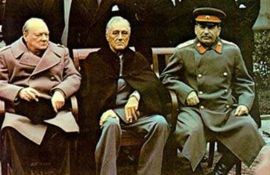
In these conferences, his first appearances on the world stage, Stalin proved to be a formidable negotiator. Anthony Eden, the British Foreign Secretary noted:
"Marshal Stalin as a negotiator was the toughest proposition of all. Indeed, after something like thirty years' experience of international conferences of one kind and another, if I had to pick a team for going into a conference room, Stalin would be my first choice. Of course the man was ruthless and of course he knew his purpose. He never wasted a word. He never stormed, he was seldom even irritated."
His shortcomings as strategist are frequently noted regarding massive Soviet loss of life and early Soviet defeats. An example of it is the summer offensive of 1942, which led to even more losses by the Red Army and recapture of initiative by the Germans. Stalin eventually recognized his lack of know-how and relied on his professional generals to conduct the war.
Yet Stalin did rapidly move Soviet industrial production east of the Volga River, far from Luftwaffe-reach, to sustain the Red Army's war machine with astonishing success. Additionally, Stalin was well aware that other European armies had utterly disintegrated when faced with Nazi military efficacy and responded effectively by subjecting his army to galvanizing terror and unrevolutionary, nationalist appeals to patriotism. He also appealed to the Russian Orthodox church and images of national Russian heroes. On November 6, 1941, Stalin addressed the whole nation of the Soviet Union for the second time (the first time was earlier that year on July 2).
According to Stalin's Order No. 227 of July 27, 1942, any commander or commissar of a regiment, battalion or army, who allowed retreat without permission from above was subject to military tribunal. The Soviet soldiers who surrendered were declared traitors; however most of those who survived the brutality of German captivity were mobilized again as they were freed. Between 5% and 10% of them were sent to Gulag (As "traitors of Homeland". Soviet Criminal Code, §58, clause 1B: criminal conviction — 10 or later 25 years of labor camp plus 5 years without "citizen rights").
In the war's opening stages, the retreating Red Army also sought to deny resources to the enemy through a scorched earth policy of destroying the infrastructure and food supplies of areas before the Germans could seize them. This, along with abuse by German troops, caused starvation and suffering among the civilian population that were left behind.
According to recent figures, of an estimated four million POWs taken by the Russians, including Germans, Japanese, Hungarians, Romanians and others, some 580,000 never returned, presumably victims of privation or the Gulags, compared with 3.5 million Soviet POW that died in German camps out of the 5.6 million taken.
Returning Soviet soldiers who had surrendered were viewed with suspicion and some were killed. According to historian Alan Bullock:
The huge number of Russian troops taken prisoner in the first eighteen months of the war convinced Stalin that many of them must have been traitors who had deserted at the first opportunity. Any soldier who had been a prisoner was henceforth suspect … All such, whether generals, officers, or ordinary soldiers, were sent to special concentration camps where the NKVD investigated them … 20% were sentenced to death or twenty-five years in camps; only 15 to 20% were allowed to return to their homes. The remainder were condemned to shorter sentences (five to ten years), to exile in Siberia, and forced labor — or were killed or died on the way home.
According to Soviet archives, the overall increase of the Gulag population was minimal during 1945-46. 3,246,000 of repatriated Soviet POWs and civilians (out of 5,917,000) returned to civilian life, 1,645,000 were drafted, 338,000 sentenced (most of them were liberated by 1953) and about half a million remained in Western countries.
Post-war era, 1945–1953
Domestically, Stalin was seen as a great wartime leader who had led the Soviets to victory against the Nazis. His early cooperation with Hitler was forgotten. That cooperation included helping the German Army violate the Treaty of Versailles limitations, with training in the Soviet Union, the notorious Molotov-von Ribbentrop treaty which partitioned Poland giving the Soviet Union what is now Belarus and granted the Soviet Union a free hand in Finland, Lithuania, Estonia, and Latvia, and Soviet trade with Hitler to counteract the expected French and British trade blockades.
By the end of the 1940s, Russian patriotism increased due to successful propaganda efforts. For instance, some inventions and scientific discoveries were claimed by Russian propaganda. Examples include the boiler, reclaimed by father and son Cherepanovs; the electric bulb, by Yablochkov and Lodygin; the radio, by Popov; and the airplane, by Mozhaysky. Stalin's internal repressive policies continued (including in newly acquired territories), but never reached the extremes of the 1930s, in part because the smarter party functionaries had learned caution.
Internationally, Stalin viewed Soviet consolidation of power as a necessary step to protect the USSR by surrounding it with countries with friendly governments like the variety seen in Finland, to act as a cordon sanitaire (buffer) against possible invaders, while the "West" sought a similar buffer against communist expansion. These competing policies led to an admirable stability, where successful Soviet aggression would depend on enthusiastic cooperation by the satellite nations.
He had hoped that the American withdrawal and demobilization would lead to increased communist influence, especially in Europe. Each side might view the other's defensive actions as destabilizing provocations and these security dilemmas frayed relations between the Soviet Union and its former World War II western allies and led to a prolonged period of tension and distrust between East and West known as the Cold War (see also Iron curtain).
The Red Army ended World War II occupying much of the territory that had been formerly held by the Axis countries:
In Asia, the Red Army had overrun Manchuria in the last month of the war and then also occupied Korea above the 38th parallel north. Mao Zedong's Communist Party of China, though receptive to minimal Soviet support, defeated the pro-Western and heavily American-assisted Chinese Nationalist Party in the Chinese Civil War.
The Communists controlled mainland China while the Nationalists held a rump state on the island of Formosa (now Taiwan). The Soviet Union soon after recognized Mao's People's Republic of China, which it regarded as a new ally. The People's Republic claimed Taiwan, though it had never held authority there.
Diplomatic relations reached a high point with the signing of the 1950 Sino-Soviet Treaty of Friendship and Alliance. Both countries provided military support to a new friendly state in North Korea. After various border conflicts, war broke out with U.S.-allied South Korea in 1950, starting the Korean War.
In Europe, there were Soviet occupation zones in Germany and Austria. Hungary and Poland were under practical military occupation. From 1946–1948 coalition governments comprising communists were elected in Poland, Czechoslovakia, Hungary, Romania and Bulgaria and homegrown communist movements rose to power in Yugoslavia and Albania.
These nations became known as the "Communist Bloc." Britain and the United States supported the anti-communists in the Greek Civil War and suspected the Soviets of supporting the Greek communists although Stalin refrained from getting involved in Greece, dismissing the movement as premature. Albania remained an ally of the Soviet Union, but Yugoslavia broke with the USSR in 1948. Greece, Italy and France received enormous support from the population, which were at the very least friendly towards Moscow.
Both Superpowers viewed Germany as key. In retaliation to the Western formation of Trizonia, Stalin determined to take action.
Armed with intelligence from the British agent Donald Duart Maclean and other British and American espionage agents, Stalin was well aware that the United States had not proceeded with mass production of atomic weapons, indeed, had not even assembled any after the last was used at Nagasaki. Large numbers would have been needed to destroy Soviet or Communist land forces either in Europe or the Far East. He therefore ordered a blockade of West Berlin, which was under British, French, and U.S. occupation, to test the Western powers.
The Berlin Blockade failed due to the unexpected massive aerial resupply campaign carried out by the Western powers known as the Berlin Airlift. In 1949, Stalin conceded defeat and ended the blockade. After West Germany was formed by the union of the three Western occupation zones, the Soviets declared East Germany a separate country in 1949, ruled by the communists.
Stalin originally supported the creation of Israel in 1948. The USSR was one of the first nations to recognize the new country. Golda Meir came to Moscow as the first Israeli Ambassador to the USSR that year. But he later changed his mind and came out against Israel.
Contrary to America's policy which restrained armament (limited equipment was provided for infantry and police forces) to South Korea, Stalin also extensively armed Kim Il Sung's North Korean army and air forces with military equipment (to include T-34/85 tanks) and "advisors" far in excess of that required for defensive purposes) in order to facilitate Kim's (a former Soviet Officer) aim to conquer the rest of the Korean peninsula. Soviet pilots flew Soviet aircraft from Chinese bases against United Nations aircraft defending South Korea. Post cold war research in Soviet Archives reveal that the Korean War was begun by Kim Il-sung with the express permission of Stalin, though this is widely disputed by North Korea.
In Stalin's last year of life, one of his last major foreign policy initiatives was the 1952 Stalin Note for German reunification and Superpower disengagement from Central Europe, but Britain, France, and the United States viewed this with suspicion and rejected the offer.
Theorist
Stalin made few contributions to Communist (or, more specifically, Marxist-Leninist) theory. The contributions he made were accepted and upheld by all Soviet political scientists during his rule. Among Stalin's contributions were his "Marxism and the National Question", a work praised by Lenin; his "Trotskyism or Leninism", which was a factor in the "liquidation of Trotskyism as an ideological trend" within the CPSU(B).
Stalin's Collected Works (in 13 volumes) was released in 1949. A subsequent 16 volume American Edition appeared, in which one volume consisted of the book "History of the CPSU(B) Short Course", although when released in 1938 this book was credited to a commission of the Central Committee.
In 1933, Stalin put forward the theory of aggravation of the class struggle along with the development of socialism, arguing that the further the country would move forward, the more acute forms of struggle will be used by the doomed remnants of exploiter classes in their last desperate efforts — and that, therefore, political repression was necessary.
In 1936, Stalin announced that the society of the Soviet Union consisted of two non-antagonistic classes: workers and kolkhoz peasantry. These corresponded to the two different forms of property over the means of production that existed in the Soviet Union: state property (for the workers) and collective property (for the peasantry). In addition to these, Stalin distinguished the stratum of intelligentsia. The concept of "non-antagonistic classes" was entirely new to Leninist theory.
Stalin and his supporters have highlighted the notion that socialism can be built and consolidated by a country as underdeveloped as Russia during the 1920s. Indeed this might be the only means in which it could be built in a hostile environment.
Death
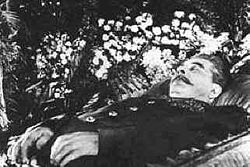
On March 1, 1953, after an all-night dinner in his residence in Krylatskoye some 15 km west of Moscow centre with interior minister Lavrentiy Beria and future premiers Georgy Malenkov, Nikolai Bulganin and Nikita Khrushchev, Stalin did not emerge from his room, having probably suffered a stroke that paralyzed the right side of his body.
Although his guards thought that it was odd for him not to rise at his usual time, they were under orders not to disturb him. He was discovered lying on the floor of his room only at about 10 p.m. in the evening. Lavrentiy Beria was informed and arrived a few hours afterwards, and the doctors arrived only in the early morning of March, 2nd. Stalin died four days later, on March 5, 1953, at the age of 74, and was embalmed on March 9. His daughter Svetlana recalls the scene as she stood by his death bed: "He suddenly opened his eyes and cast a glance over everyone in the room. It was a terrible glance. Then something incomprehensible and awesome happened. He suddenly lifted his left hand as though he were pointing to something above and bringing down a curse upon all of us. The next moment after a final effort the spirit wrenched itself free of the flesh." Officially, the cause of death was listed as a cerebral hemorrhage. His body was preserved in Lenin's Mausoleum until October 31, 1961, when his body was removed from the Mausoleum and buried next to the Kremlin walls as part of the process of de-Stalinization.
It has been suggested that Stalin was assassinated. The ex-Communist exile Avtorkhanov argued this point as early as 1975. The political memoirs of Vyacheslav Molotov, published in 1993, claimed that Beria had boasted to Molotov that he poisoned Stalin: "I took him out."
Khrushchev wrote in his memoirs that Beria had, immediately after the stroke, gone about "spewing hatred against [Stalin] and mocking him", and then, when Stalin showed signs of consciousness, dropped to his knees and kissed his hand. When Stalin fell unconscious again, Beria immediately stood and spat.
In 2003, a joint group of Russian and American historians announced their view that Stalin ingested warfarin, a powerful rat poison that inhibits coagulation of the blood and so predisposes the victim to hemorrhagic stroke (cerebral hemorrhage). Since it is flavorless, warfarin is a plausible weapon of murder. The facts surrounding Stalin's death will probably never be known with certainty.
His demise arrived at a convenient time for Beria and others, who feared being swept away in yet another purge. It is believed that Stalin felt Beria's power was too great and threatened his own. Whether or not Beria or another usurper was directly responsible for his death, it is true that the Politburo did not summon medical attention for Stalin for more than a day after he was found.
Marriages and family
Stalin met his first wife, Ekaterina Svanidze, in late 1905 when he moved into the Tiflis townhouse where she lived. They were married on the night of July 28 1906. On March 31 1907, she gave birth to Stalin's first child, Yakov. In June 1907, after robbing the bank in Tiflis to fund the Bolshevik cause, Stalin and his family fled east to Baku. Stalin was frequently absent as he conducted revolutionary work across Georgia. Meanwhile, his Ekaterina suffered under the pollution and heat of Baku, which was an oil boomtown. She contracted typhus and died on December 5 1907. Stalin was devastated by her death; fearing he was suicidal, his friends took away his pistol.
His son finally shot himself because of Stalin's harshness toward him, but survived. After this, Stalin said "He can't even shoot straight". Yakov served in the Red Army during World War II and was captured by the Germans. They offered to exchange him for Field Marshal Friedrich Paulus, who had surrendered after Stalingrad, but Stalin turned the offer down, allegedly saying "A lieutenant is not worth a general"; others credit him with saying "I have no son," to this offer. Afterwards, Yakov is said to have committed suicide, running into an electric fence in Sachsenhausen concentration camp, where he was being held.
Stalin had a son, Vasiliy, and a daughter, Svetlana, with his second wife Nadezhda Alliluyeva. She died in 1932, officially of illness. She may have committed suicide by shooting herself after a quarrel with Stalin, leaving a suicide note which according to their daughter was "partly personal, partly political". According to A&E Biography, there is also a belief among some Russians that Stalin himself murdered his wife after the quarrel, which apparently took place at a dinner in which Stalin tauntingly flicked cigarettes across the table at her. Historians also claim that her death ultimately "severed his [Stalin's] link from reality."
Vasiliy rose through the ranks of the Soviet air force, officially dying of alcoholism in 1962; however, this is still in question. He distinguished himself in World War II as a capable airman. Svetlana emigrated to the United States in 1967.
In his book The Wolf of the Kremlin Stuart Kahan claimed that Stalin was secretly married to a third wife named Rosa Kaganovich, allegedly the sister of Lazar Kaganovich, a Soviet politician. However, the claim is unproven and many have disputed it, including the Kaganovich family, who deny that "Rosa" and Stalin ever met, and even state that Kaganovich's sister wasn't named Rosa. Kahan also claimed that both Lazar and Rosa were responsible for the death of Stalin (by poisoning), however this (as well as most of the remainder of Kahan's assertions) were dismissed as fabrication by the Statement of the Kaganovich Family.
In March 2001 Russian Independent Television NTV discovered a previously unknown grandson living in Novokuznetsk. Yuri Davydov told NTV that his father had told him of his lineage, but, because the campaign against Stalin's cult of personality was in full swing at the time, he was told to keep quiet. The Soviet dissident writer, Aleksandr Solzhenitsyn, had mentioned a son being born to Stalin and his common-law wife Lida in 1918, during Stalin's exile in northern Siberia.
Religious beliefs
Stalin's beliefs are complicated and sometimes contradictory. He received his education at the Theological Seminary at Tbilisi, where his mother sent him to become a priest, but he became a closet atheist.
Regarding one famous claim about evolution, historians doubt one later Soviet claim that he read The Origin of Species at the age of thirteen while still at Gori, and told a fellow pupil that it proved the nonexistence of God. The story fails on several obvious accounts, including Stalin's remaining religious, even pious, for some years longer. In fact Professor of Religion Hector Avalos noted, "Stalin, in fact, had a complex relationship with religious institutions in the Soviet Union."
Historian Edvard Radzinsky used recently discovered secret archives and noted a story that changed Stalin's attitude toward religion. The story in which Ilya, Metropolitan of the Lebanon Mountains, claimed to receive a sign from heaven that "The churches and monasteries must be reopened throughout the country. Priests must be brought back from imprisonment, Leningrad must not be surrendered, but the sacred icon of Our Lady of Kazan should be carried around the city boundary, taken on to Moscow, where a service should be held, and thence to Stalingrad Tsaritsyn." Shortly thereafter, Stalin's attitude changed and "Whatever the reason, after his mysterious retreat, he began making his peace with God. Something happened which no historian has yet written about. On his orders many priests were brought back to the camps. In Leningrad, besieged by the Germans and gradually dying of hunger, the inhabitants were astounded, and uplifted, to see wonder-working icon Our Lady of Kazan brought out into the streets and borne in procession." Radzinsky asked, "Had he seen the light? Had fear made him run to his Father? Had the Marxist God-Man simply decided to exploit belief in God? Or was it all of these things at once?."
During the Second World War Stalin reopened the Churches. One reason could have been to motivate the majority of the population who had Christian beliefs. The reasoning behind this is that by changing the official policy of the party and the state towards religion, the Church and its clergymen could be to his disposal in mobilizing the war effort.
Cult of personality
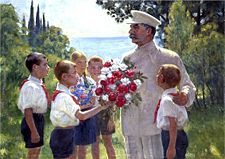
Stalin created a cult of personality in the Soviet Union around both himself and Lenin. The embalming of the Soviet founder in Lenin's Mausoleum was performed over the objection of Lenin's widow, Nadezhda Krupskaya. Stalin became the focus of massive adoration and even worship.
Numerous towns, villages and cities were renamed after the Soviet leader (see List of places named after Stalin) and the Stalin Prize and Stalin Peace Prize were named in his honour. He accepted grandiloquent titles (e.g. "Coryphaeus of Science," "Father of Nations," "Brilliant Genius of Humanity," "Great Architect of Communism," "Gardener of Human Happiness," and others), and helped rewrite Soviet history to provide himself a more significant role in the revolution. At the same time, according to Khrushchev, he insisted that he be remembered for "the extraordinary modesty characteristic of truly great people."
Many statues and monuments were erected to glorify Stalin but all of them distorted Stalin's true build. Going by these monuments and statues it would be easy to assume that Stalin was a tall and well built man not unlike Tsar Alexander III. This was not the case however; photographic evidence suggests he was between 5 ft 5 in and 5 ft 6 in (165–168 cm). His physical stature was exaggerated in all portraits and statues to avoid any image of weakness that could harm his cult of personality.
Trotsky criticized the cult of personality built around Stalin as being against the values of socialism and Bolshevism, in that it exalted the individual above the party and class and it disallowed criticism of Stalin. The personality cult reached new levels during the Great Patriotic War, with Stalin's name even being included in the new Soviet national anthem. The reference was later removed during the process of De-Stalinization. Also the soldiers of the Red Army when they charged into battle, they would not only yell out "FOR THE MOTHERLAND", but also most, if not all would also yell out "FOR STALIN". Also the Iosif Stalin tank class was named after Stalin.
Stalin became the focus of a body of literature encompassing poetry as well as music, paintings and film. Artists and writers vied with each other in fawning devotion, crediting Stalin with almost god-like qualities, and suggesting he single-handedly won the Second World War.
It is debatable as to how much Stalin relished the cult surrounding him. The Finnish communist Tuominen records a sarcastic toast proposed by Stalin at a New Year Party in 1935:
Comrades! I want to propose a toast to our patriarch, life and sun, liberator of nations, architect of socialism [he rattled off all the appellations applied to him in those days] — Joseph Vissarionovich Stalin, and I hope this is the first and last speech made to that genius this evening.
In recent years, support of Stalin has resurged. Millions of Russians, exasperated with the downfall of the economy and political instability after the breakup of the Soviet Union, want Stalin back. A recent controversial poll revealed that over thirty-five percent of Russians would vote for Stalin if he were still alive. This is seen by some as a return of Stalin's cult. In Krasnoyarsk, it has been decided to rebuild a communist-era memorial complex dedicated to Josef Stalin. Also, a new statue of Stalin is to be erected in Moscow, “returning his once-ubiquitous image to the streets after an absence of four decades, a top city official said yesterday”, as reported by The Scotsman.
A survey from late 2006 revealed that 47% of Russian respondents viewed Stalin as a positive figure, and only 29% as a negative one. Some controversy also ensued when a recently approved history textbook for Russia’s schoolchildren attempted to illustrate Stalin’s purges as a necessary evil in the process of state-building. In July 2008, Stalin topped at the list of most popular figures of the Russian history and culture in the nationwide television project " Name of Russia. Historical Choice 2008" in which 178,881 out of 1,453,390 voted for him.
Policies and accomplishments
Under Stalin's rule, the Soviet Union was transformed from an agricultural nation into a global superpower, although at the cost of an estimated 30 million lives. The USSR's industrialization was successful in that the country was able to defend against and defeat the Nazi invasion in World War II, though at an enormous cost in human life. In 1957, four years after Stalin's death, the nation put into orbit the first artificial satellite, Sputnik 1.
Libertarian historian Robert Conquest and some other Westerners claim that the USSR was bound for industrialization, and that its speed along this course was not necessarily improved by the Bolsheviks. Other historians argue that Stalin was partly responsible for the initial military disasters and enormous human casualties during WWII, because he eliminated so many experienced military officers during the purges. He especially attacked the most senior officers and had rejected intelligence warning of the German attack.
While Stalin's social and economic policies laid the foundations for the USSR's emergence as a superpower, the harshness with which he conducted Soviet affairs was subsequently repudiated by his successors in the Communist Party leadership, notably in the denunciation of Stalinism by Nikita Khrushchev in February 1956. In his "Secret Speech", On the Personality Cult and its Consequences, delivered to a closed session of the 20th Party Congress of the Communist Party of the Soviet Union, Khrushchev denounced Stalin for his cult of personality, and his regime for "violation of Leninist norms of legality".
Stalin's immediate successors preserved major elements of his rule, including the political monopoly of the Communist Party's presiding over a command economy and a security service able to suppress dissent. The large-scale purges of Stalin's era were never repeated, but political repression continued, albeit on a lesser scale.
Origin of name, nicknames and pseudonyms
His first name is also transliterated as Iosif. His original surname, ჯუღაშვილი, is also transliterated as Jugashvili or Jughashvili. The Russian transliteration is Джугашвили, which is in turn transliterated into English as Dzhugashvili and Djugashvili; -შვილი (-shvili) is a Georgian suffix meaning "child" or "son".
There are several etymologies of the ჯუღა (jugha) root. In one version, it is the Ossetian for "rubbish"; the surname Jugayev is common among Ossetians, and before the revolution the names in South Ossetia were traditionally written with the Georgian suffix, especially among Christianized Ossetians. In a second version, the name derives from the village of Jugaani in Kakhetia, eastern Georgia.
An article in the newspaper Pravda in 1988 claimed the word derives from the Old Georgian for "steel" which might be the reason for his adoption of the name Stalin. Сталин (Stalin) is derived from combining the Russian сталь (stal), "steel", with the possessive suffix -ин (-in), a formula used by many other Bolsheviks, including Lenin.
Like other Bolsheviks, he became commonly known by one of his revolutionary noms de guerre, of which Stalin was only the most prominent. During his education in Tiflis, he picked up the nickname Koba, a Robin Hood-like brigand and protagonist from the 1883 novel The Patricide by Alexander Kazbegi, this became his favorite nickname throughout his revolutionary life. During conversations, Vladimir Lenin called Stalin "Koba". Among his friends he was sometimes known by his childhood nickname Soso or Sosso.
Stalin is also reported to have used at least a dozen other names for the purpose of secret communications. Other nicknames, pseudonyms and aliases were Josef Besoshvili; Besov; Ivanov; A. Ivanovich; Soselo or Ryaboi Soselo (a youthful nickname), David K. Kato; G. Nizharadze or G. Nijeradze; Chizhikov or Chizhnikov; Oranness; Vartanovich; Totomyans; Vassilyi and J.V. Stalin. Directly following World War II, as the Soviets were negotiating with the Allies, Stalin often sent directions to Molotov as Druzhkov.
Stalin was nicknamed "Uncle Joe" by the Western media.
Hypotheses, rumors, and misconceptions about Stalin
For a long time the date of birth of Stalin was falsified.
There are a number of hypotheses and popular rumors about the "real" father of Stalin; also see "Death" section for hypotheses about the causes of Stalin's death.
Suspected Tsarist connections
Stalin has been suspected in the past and in the present of being a Tsarist double-agent during his revolutionary years. Some of this suspicion stems from his ability to evade Tsarists efforts to capture him. His 1909 efforts to root out traitors caused much strife within the party; some accused him of doing this deliberately on the orders of the Okhrana. The Menshevik Razhden Arsenidze said that Stalin was betraying comrades he didn't like to the Okhrana, but there is no proof of this. His ability to anticipate Okhrana actions may have come from moles within the organization. Another historian, Simon Sebag Montefiore, found that in all surviving Okhrana records Stalin is described as a revolutionary and never a spy. In the 1956, the magazine Life published a letter by Colonel Ermin, head of the Tiflis Okhrana, that said Stalin was an agent, but it has since been shown to be a forgery.
In his 1967 biography of Stalin, Edward Ellis Smith argued that Stalin was an Okhrana agent by citing his suspicious ability to escape from Okhrana dragnets, travel unimpeded, and rabble-rouse full time with no apparent source of income. One such example was the raid that occurred on the night of April 3 1901, when most everyone of importance in the Socialist-Democratic movement in Tiflis was arrested, except for Stalin, who was apparently "enjoying the balmy spring air, and in one of his to-hell-with-the-revolution moods, [which] is too impossible for serious consideration."
